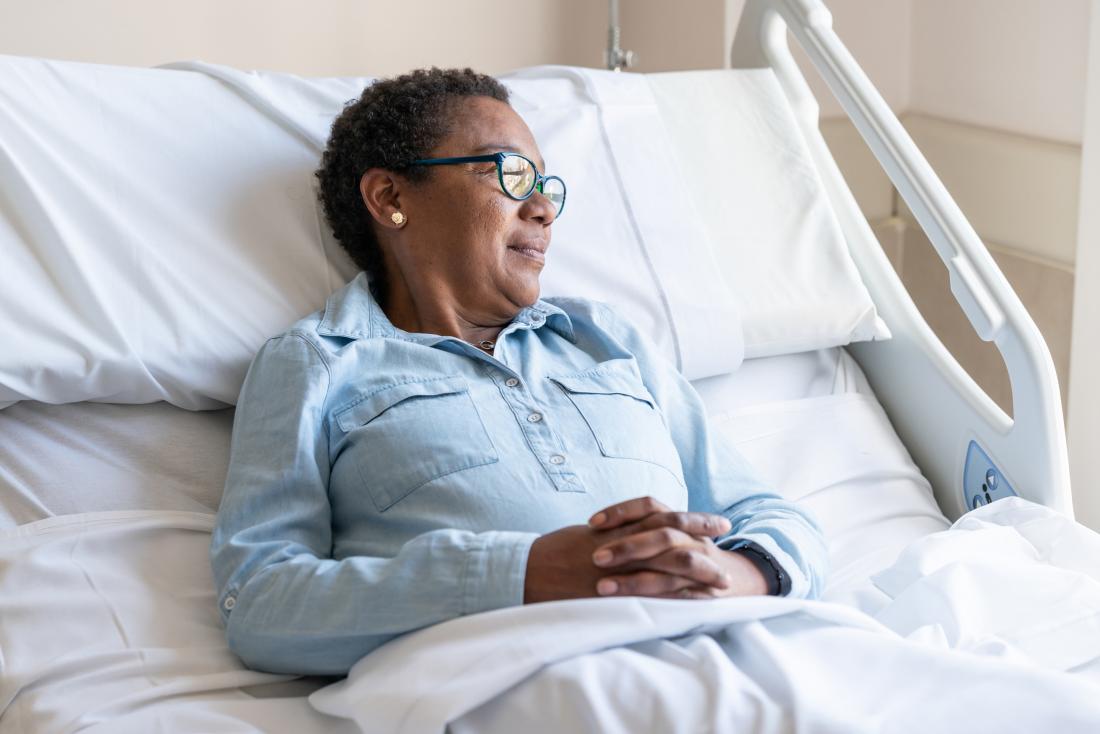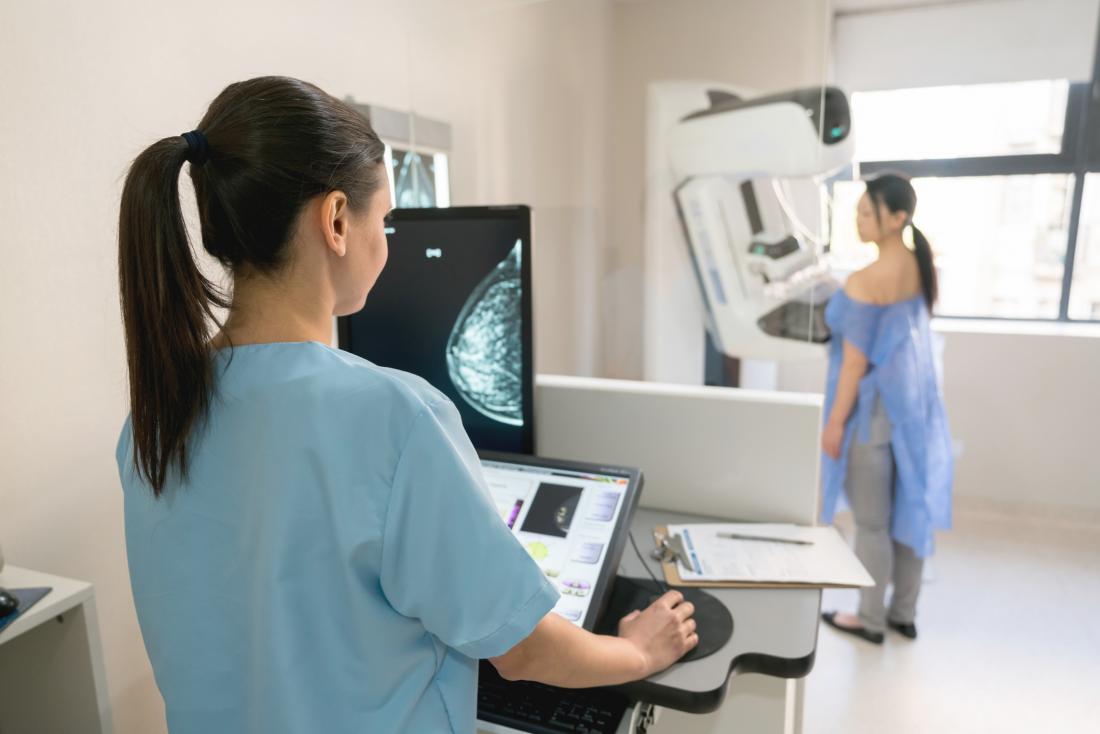Breast cancer develops when the cells in the breast grow uncontrollably to form a tumor. Malignant tumors can spread into surrounding tissue or even to distant parts of the body. However, early diagnosis and treatment can help prevent this.
According to the American Cancer Society (ACS), breast cancer is the most common type of cancer, other than non-melanoma skin cancer, in females in the United States. Around 1 in 8 females in the U.S. will develop breast cancer at some point in their life.
Knowing the risk factors for breast cancer can help a person make decisions regarding screening and lifestyle habits.
In this article, we look at the link between age and the risk of breast cancer. We also discuss other breast cancer risk factors, as well as the risks and benefits of undergoing regular screening.
Average age of breast cancer diagnosis

Females over 50 years of age are more likely to receive a breast cancer diagnosis.
A person’s risk of developing breast cancer increases as they get older. As people age, abnormal changes in their cells are more likely to occur.
Breast cancer is most common in females over the age of 50 years. According to the National Cancer Institute (NCI), doctors most often diagnose breast cancer in females aged 55–64 years.
Based on data from 2012–2016, the median age of diagnosis in females with breast cancer was 62 years old.
Risk for different age groups
Although females are more likely to develop breast cancer after they reach the age of 50 years, younger women can also develop this condition.
According to the NCI, the risk that a doctor will diagnose breast cancer in a female in the United States within the next 10 years is:
- 1 in 227 (0.44%) for those aged 30 years
- 1 in 68 (1.47%) for those aged 40 years
- 1 in 42 (2.38%) for those aged 50 years
- 1 in 28 (3.56%) for those aged 60 years
- 1 in 26 (3.82%) for those aged 70 years
The NCI also report that of the 437,722 females that doctors diagnosed breast cancer in between 2012 and 2016:
- 1.9% were aged 20–34 years
- 8.4% were aged 35–44 years
- 20.1% were aged 44–55 years
- 25.6% were aged 55–64 years
- 24.8% were aged 65–74 years
- 13.7% were aged 75–84 years
- 5.6% were aged 84 years+
Other risk factors for breast cancer
Age is just one risk factor for developing breast cancer. Some other risk factors that people cannot control include:
Being female
Breast cancer can develop in both males and females. However, the ACS report that females are 100 times more likely to develop breast cancer than males.
Breast density
Breasts contain fatty tissue and connective tissues. These types of tissue show up differently in mammograms. Doctors describe breasts that contain more connective than fatty tissues as being “mammographically dense.”
Females with mammographically denser breasts are more likely to develop breast cancer than those of a similar age with less mammographically dense breasts.
Genetic mutations
The BRCA1 and BRCA2 genes make proteins involved in the repair of DNA in specific tissues, such as the breasts. Changes, or mutations, to these genes can significantly increase the risk of breast cancer.
According to the ACS, females who inherit the BRCA1 or BRCA2 gene mutation have a roughly 70% chance of developing breast cancer by the age of 80 years.
Females with these genetic mutations are also more likely develop breast cancer at a younger age and to have cancer in both breasts. They also have a higher risk of ovarian cancer.
Changes to a number of other genes can also increase a person’s risk of breast cancer.
Family history of breast cancer
Having a family history of breast cancer increases a person’s risk of developing the condition themselves.
A female’s risk almost doubles if they have a first degree relative who has had breast cancer and triples if they have two first degree relatives who have had it. First degree relatives are parents, siblings, and children and can include males.
Menstrual and reproductive history
The menstrual cycle increases levels of the female sex hormones estrogen and progesterone in the body.
Starting menstrual periods at a younger age or going through menopause at a later age raises the body’s exposure to these hormones, which can increase a person’s risk of breast cancer.
Those who start their menstrual period before the age of 12 years and those who go through menopause after the age of 55 years have an increased risk of breast cancer.
Females who have never given birth at full-term and those who had their first full-term pregnancy after the age of 30 years also have a higher risk of breast cancer, according to the NCI.
Diethylstilbestrol treatment
Diethylstilbestrol is a drug that doctors prescribed to some pregnant women between 1940 and 1971 to prevent miscarriage. Women who took this drug while pregnant and any children they gave birth to have a slightly higher risk of breast cancer.
Personal history of breast disease
Females who have previously had breast cancer are at risk of developing a second breast cancer, either in the other breast or in a different part of the same breast. This is not the same as the first cancer returning.
Having a personal history of certain noncancerous breast conditions can also increase a person’s risk of breast cancer. This can include conditions such as atypical hyperplasia, lobular carcinoma in situ, and ductal carcinoma in situ.
Having had radiation therapy
Females who have had radiation therapy to the chest or breasts, such as for Hodgkin lymphoma, before the age of 30 years have a higher chance of developing breast cancer.
This risk varies with age and is highest in people who were in their teens when they had radiation treatment. According to the ACS, having radiation therapy after the age of 40 years does not seem to increase a person’s risk of breast cancer.
Lifestyle risk factors

A more active lifestyle may help to reduce the risk of developing breast cancer.
A number of lifestyle factors can increase someone’s risk of breast cancer. Being aware of these factors can help them reduce their breast cancer risk.
These lifestyle factors include:
- Being inactive: Physical inactivity increases a person’s risk of breast cancer. Getting regular exercise may help reduce this risk.
- Taking hormones: Some types of hormone replacement therapy and hormonal birth control may increase the risk of breast cancer. Finding nonhormonal alternatives may reduce a person’s chance of developing breast cancer.
- Being overweight after menopause: After menopause, people who are overweight are more likely to develop breast cancer. Maintaining a healthy weight may help reduce breast cancer risk.
- Drinking alcohol: According to the ACS, there is a link between alcohol consumption and the risk of breast cancer. The more a person drinks, the greater their risk. So, drinking less alcohol may reduce the risk of breast cancer as well as some other types of cancer.
Who should get screened?
The U.S. Preventive Services Task Force suggest that females aged 50–74 years who are at average risk of developing breast cancer should go for screening every 2 years.
Those aged 40–49 years, particularly those with a higher risk of breast cancer, should speak to their doctor about the risks and benefits of undergoing regular screening.
Doctors tend to use a mammogram to screen people for breast cancer. A mammogram is a breast X-ray that can help detect breast cancer early on, before it starts to produce symptoms.
Other exams available for people at a higher risk of breast cancer include:
- breast MRI scan
- a clinical breast exam, wherein a healthcare professional uses their hands to feel for lumps and changes in a person’s breasts
Risks and benefits of screening

Regular breast screening can increase the chance of detecting breast cancer in its early stages.
There are both risks and benefits associated with regularly screening for breast cancer. Many people conclude that the benefits outweigh the risks, but getting screened is a personal decision.
The risks of screening for breast cancer include:
- False positives: A false positive occurs when a test result falsely suggests that a person has cancer. False positives can prompt additional tests, which may cause anxiety and can be expensive and time consuming.
- Overtreatment: Some cancers are benign and do not go on to cause symptoms or other problems. Treating these types of cancers is called overtreatment, and it can lead to unnecessary side effects, expense, and anxiety.
- False negatives: A false negative occurs when a test result misses the presence of a cancer. False negatives can delay diagnosis and treatment.
The main benefit of undergoing regular screening is that it increases the chance of detecting breast cancer in its early stages. Early diagnosis makes the treatment of breast cancer more effective, which can improve a person’s outlook.
Summary
As people get older, their risk of breast cancer increases. Doctors most commonly diagnose breast cancer in females over the age of 50 years.
However, there are many other factors that can affect a person’s risk of developing breast cancer.
A person has no control over some of these risk factors, such as family history and genetics. However, there are also a number of lifestyle factors — including alcohol consumption and physical activity levels — that people can change to help reduce their risk of this condition.
People can discuss their risk factors for breast cancer with a doctor, who can advise on the risks and benefits of undergoing regular screening.
